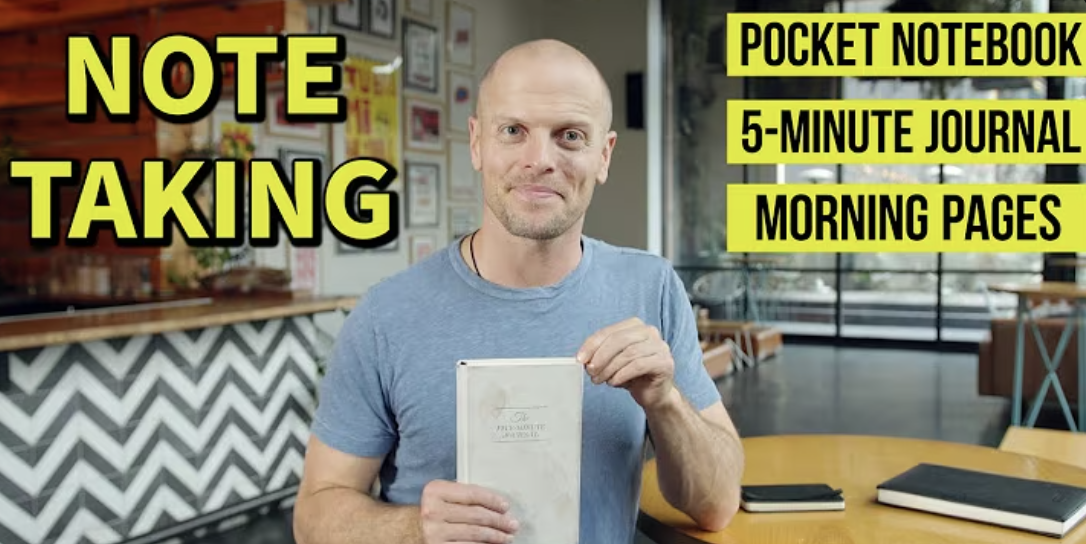The Art of Reflective Journaling: How Tim Ferriss Turns Writing into a Mental Health Practice
Discover how Tim Ferriss’s note-taking and journaling systems double as science-backed mental health practices. Learn his frameworks — Morning Pages, Brain Dump Lists, and the Five-Minute Journal — plus 10 powerful journaling prompts for mental clarity, focus, and emotional well-being.

Most people think journaling is about recording thoughts.
For Tim Ferriss, it’s about redirecting attention.
He calls it “hypergraphia” — the compulsive urge to write — and over decades of relentless note-taking, he discovered something unexpected: writing can be an operating system for the mind.
This article explores how Ferriss’s note-taking and journaling methods — from “crazy-idea lists” to the Five-Minute Journal and Morning Pages — serve as powerful mental health prompts for reducing anxiety, increasing focus, and improving decision clarity.
1. Why Structured Journaling Beats Overthinking
Our brains are not designed to store — they’re designed to process.
When you externalize thoughts onto paper, you relieve your prefrontal cortex from holding too many open loops.
Neuroscientists call this cognitive offloading.
Ferriss’s approach to note-taking acts as a form of mental decluttering — converting background mental noise into visible data. Once it’s out of your head, you can analyze, prioritize, and let go.
Research Insight
Studies show that expressive writing reduces cortisol levels and improves emotional regulation (Pennebaker, 2018).
Structured journaling also increases goal clarity and lowers rumination — both predictors of better mental health.
2. The Three Systems That Keep Ferriss Sane
Ferriss’s writing life runs on three frameworks. Each serves a different purpose for managing the mind.
1. The Brain Dump Notebook — Catch Everything
“When I feel overwhelmed, I list the craziest things I could do or eliminate.” — Tim Ferriss
He starts by dumping absurd ideas:
“Shut down blog,” “Sell all homes,” “Volunteer in a retirement home,” “Stop social media for three months.”
The purpose isn’t to execute — it’s to stretch imagination beyond anxiety.
In creativity research, this is known as divergent thinking, which temporarily silences the amygdala’s stress loop and activates the prefrontal cortex for possibility.
Journaling Prompt #1:
“What’s the craziest thing I could stop, start, or change to reduce stress?”
Journaling Prompt #2:
“If I had to reset my life in 30 days, what would I eliminate first?”
Ferriss reviews his lists in multiple passes — circling insights, boxing ideas, then revisiting weeks later to highlight what still matters.
This recursive review process filters chaos into clarity — a core mental-health practice disguised as productivity.
2. Morning Pages — Emotional Detox
Popularized by Julia Cameron (The Artist’s Way), Morning Pages are Ferriss’s antidote to anxiety.
He calls them “brain vomit” — three pages of uncensored handwriting each morning. The goal isn’t coherence; it’s catharsis.
Neuroscientifically, this practice moves thoughts from the limbic system (emotional center) to the prefrontal cortex (language and logic), reducing the emotional charge.
Journaling Prompt #3:
“What am I anxious about today — and what’s the worst that could happen?”
Journaling Prompt #4:
“If I wrote every fear down until it became boring, what would remain?”
The effect is similar to exposure therapy: writing your worries repeatedly weakens their emotional grip.
Ferriss uses Morning Pages not to find answers, but to trap overthinking on paper — clearing mental space for the day ahead.
3. The Five-Minute Journal — Gratitude with Discipline
Ferriss says complexity fails. That’s why he keeps a short gratitude ritual through the Five-Minute Journal, structured into two parts:
Morning (AM)
- Three things I’m grateful for
- Three things that would make today great
- Daily affirmation: “I am…”
Evening (PM)
- Three amazing things that happened
- How could I have made today better?
This structure leverages behavioral activation — small, consistent reflections that train your brain for optimism.
MRI studies show gratitude journaling increases activity in the medial prefrontal cortex — the region linked to long-term well-being and decision stability.
Journaling Prompt #5:
“What tiny detail today made life feel beautiful?”
Journaling Prompt #6:
“How could I make tomorrow 1% better?”
Ferriss also reviews his entries quarterly, spotting recurring emotional patterns. His most common realization: “Drink less coffee. Wake up earlier.”
Small truths, big changes.
3. How Note-Taking Becomes Therapy Without Calling It Therapy
Ferriss doesn’t journal about emotions — he journals through them.
Each note system serves a cognitive function:
| Type | Purpose | Psychological Effect |
|---|---|---|
| Brain Dump Lists | Creative overwhelm relief | Releases anxiety by visualizing chaos |
| Morning Pages | Emotional catharsis | Reduces limbic reactivity |
| Five-Minute Journal | Gratitude focus | Builds positive emotional bias |
| Review System | Pattern recognition | Increases metacognition and self-trust |
Together, they form a mental feedback loop — a lightweight self-therapy process that strengthens self-awareness and emotional regulation.
“You can’t fix what you can’t see. Journaling makes the invisible visible.” — Tim Ferriss
4. The “Multiple-Pass” Method: Refining Ideas Like Wine
One of Ferriss’s core insights is that brilliance emerges through multiple passes.
You don’t know what matters until you see it twice.
His 3-Pass Review System:
- First pass: Dump ideas fast — no editing.
- Second pass: Circle, box, or tag what feels alive.
- Third pass (weeks later): Highlight what still resonates — this becomes actionable insight.
Psychologically, this mimics exposure desensitization — your brain recalibrates emotional weight through repeated, distanced review.
It’s journaling meets behavioral neuroscience.
Journaling Prompt #7:
“When I reread old notes, what truths keep returning?”
5. Why Simplicity Heals the Mind
Ferriss’s rule: “Simple systems survive emotional storms.”
When you’re anxious or depressed, cognitive bandwidth collapses.
Complex journaling apps or elaborate productivity setups become self-sabotage.
The simpler the system, the more consistently you’ll use it — and consistency rewires the brain.
So choose one small ritual:
- Morning Pages for emotional detox
- Five-Minute Journal for gratitude
- Brain Dump Lists for problem-solving
Then, review once a week. Let it become your calibration point.
6. New Science, Ancient Wisdom
The reason Ferriss’s note-taking system works so well isn’t luck — it’s alignment with how the brain and nervous system regulate emotion.
| Mechanism | Supported By | Benefit |
|---|---|---|
| Expressive writing | Pennebaker, 2018 | Emotional regulation, immune resilience |
| Gratitude journaling | Kini et al., 2016 | Increased long-term happiness |
| Self-distanced reflection | Kross & Ayduk, 2011 | Decreases rumination |
| Cognitive offloading | Risko & Gilbert, 2016 | Reduces mental fatigue |
These aren’t “self-help hacks.”
They’re repeatable, neuroscience-backed behaviors that cultivate psychological resilience.
7. 10 Reflective Prompts Inspired by Tim Ferriss’s Note-Taking
These combine Ferriss’s frameworks into a mental health journaling toolkit:
- What’s the most absurd solution to my current problem?
- What am I overcomplicating that could be simple?
- What’s a tiny decision that’s stealing 80% of my mental energy?
- What emotion am I resisting by staying busy?
- What would I eliminate if I trusted things would work out?
- What did I learn from today’s mistakes?
- What three small things brought me joy today?
- What habit do I keep promising to change but don’t — and why?
- What am I grateful for that I usually overlook?
- What’s one belief I can update this week?
8. Turning Notes into Mental Fitness
Ferriss often says: “Writing is thinking.”
But more accurately, writing is cognitive training.
Each note, list, or journal entry is a rep — building the neural strength to manage uncertainty, emotion, and decision fatigue.
You don’t need 100 notebooks to start.
You need one small daily ritual that turns chaos into clarity.
“Write to think. Review to learn. Simplify to live.” — Life Note
FAQ
1. How is note-taking different from journaling?
Note-taking captures information. Journaling processes emotion. Ferriss blends both — turning external notes into internal insight.
2. How often should I review my notes?
Ferriss recommends multiple passes: immediately after, a week later, and a quarter later. This builds clarity through time.
3. Can I do this digitally?
Yes. Use Life Note or any tool that lets you tag, review, and reflect. The key is consistency, not the medium.
4. How does journaling improve mental health?
It lowers emotional reactivity, builds awareness, and strengthens the neural circuits that regulate focus and stress.
5. What’s the fastest way to start?
Use one of Ferriss’s prompts: “What’s the craziest thing I could eliminate to feel better?”
Write for 10 minutes — no censoring, no judgment.
Watch the Video: My Personal Journaling System for Deep Focus & Less Stress
My Personal Journaling System for Deep Focus & Less Stress
Related Blog Posts






